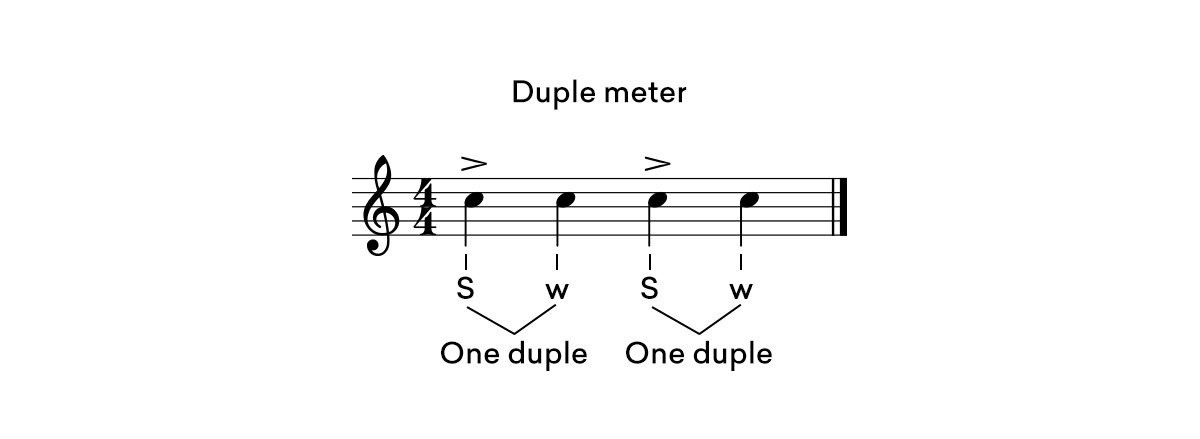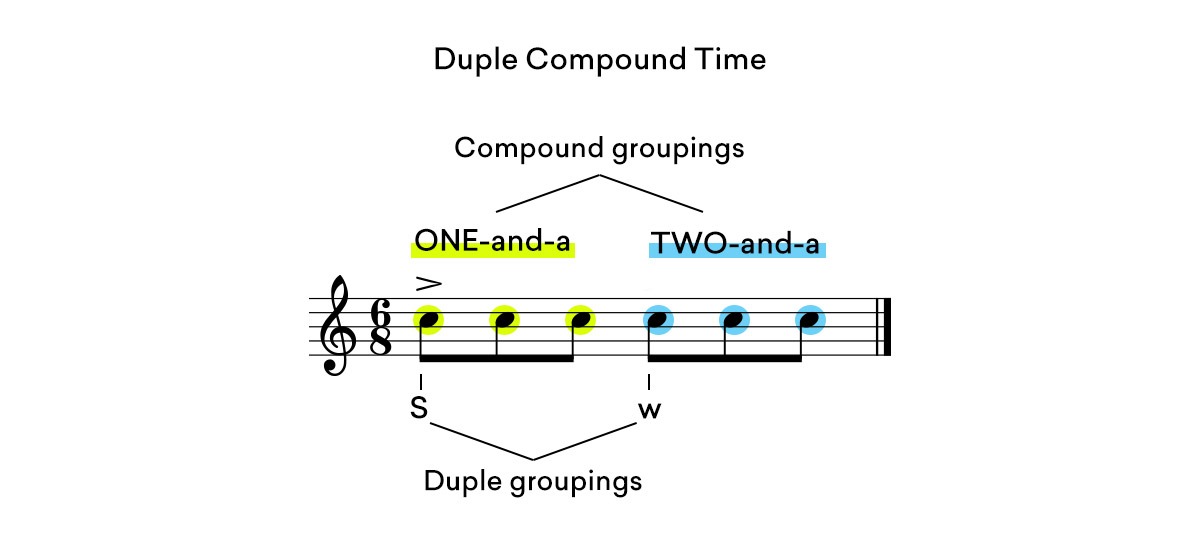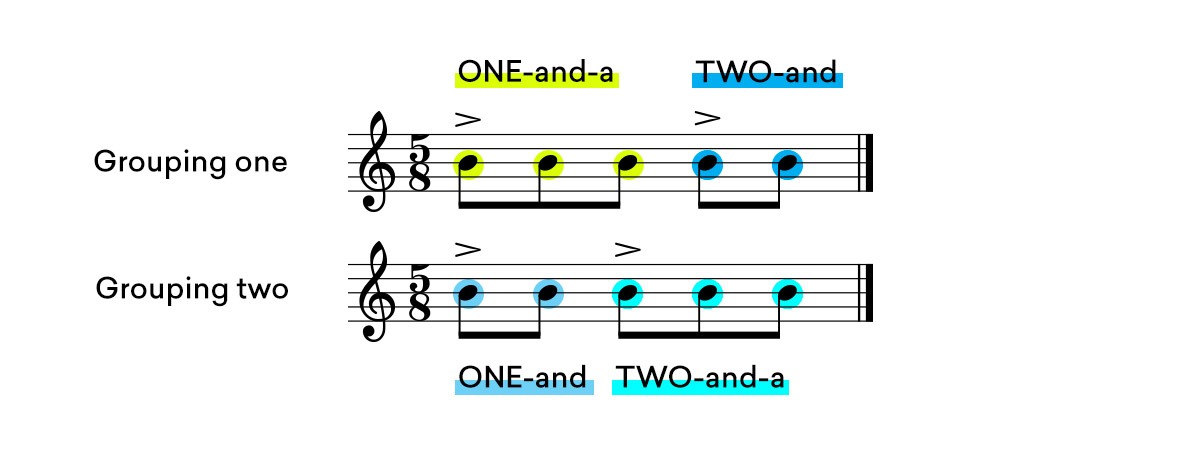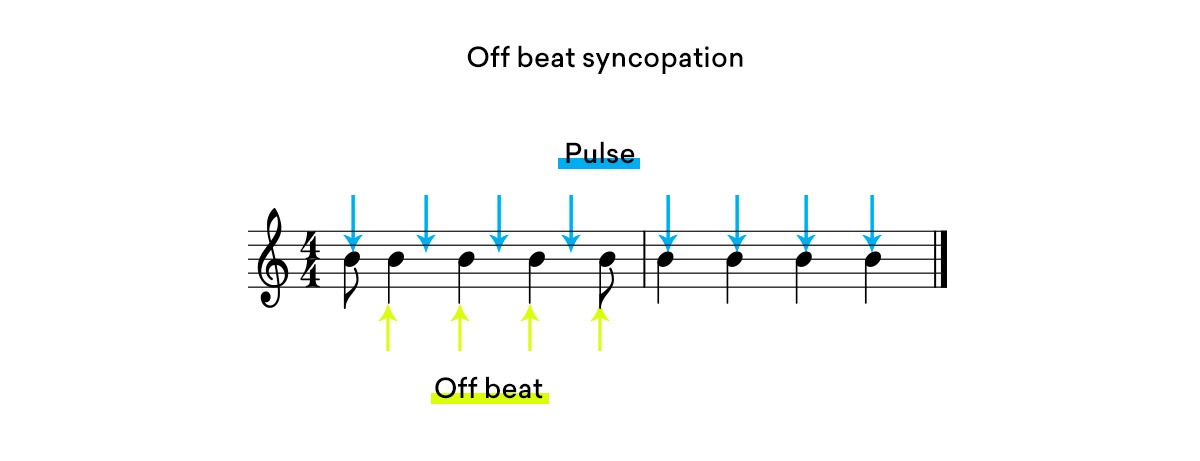Keep reading to explore more knowledge if you need to know what Rhythm is and how to apply it to your creating music process.
4. Duple and Triple Meter
So far we’ve only discussed 3/4 and 4/4 time which are the two most common time signatures.
If you are interested in using compound time and odd time in your track, you need to understand how beats within any measure are felt in twos or threes.
It makes a bit more sense once you know how strong and weak beats work.
One way to visualize triple and duple meter is to imagine the difference between a rolling triangle and a rolling square with each new revolution being where the strong beat falls.
One way to visualize triple and duple meter is to imagine the difference between a rolling triangle and a rolling square
If you look at the strong and weak beats in a 4/4 bar, they can be separated into two groups of two duples– strong then weak, strong then weak.
A strong-weak pattern signifies that duple meter is in play.
Since the bar is divided into two duples, 4/4 time is also sometimes referred to as quadruple time.
In a 3/4 bar, it’s just one triple group– strong, weak, weak.
A strong-weak-weak pattern signifies that triple meter is in play.
Any rhythmic pattern or time signature can be divided into meters of two or three.
However, a meter isn’t the only way that beats are subdivided within a measure, simple and compound time adds another set of rules.
5. Simple vs. compound time
Simple and compound time have a direct relation with a meter.
Meter defines the way the rhythm is felt in terms of strong and weak beats.
Simple and compound time dictate whether a measure’s shorter notes (usually eighth notes) are divided into groups of either two or three.
Simple time groups eighth notes into groups of two.
4/4 time is a simple duple time. Its eight notes are counted ONE-and, two-and, THREE-and, four-and.
3/4 time is simple triple time. It is counted ONE-and, two-and, three-and.
Compound time groups eighth notes into groups of three.
Here, 6/8 and 9/8 are great examples of compound time.
In 6/8 compound duple time, notes are subdivided into two groups of three eighth notes.
The eighth notes could be counted ONE-and-a, TWO-and-a.
You should here Drake’s song Plastic Bag. It is an example of a popular song that follows a 6/8 rhythm.
In 9/8 compound triple time notes are subdivided into three groups of three eighth notes.
The eighth notes are counted ONE-and-a, TWO-and-a, THREE-and-a.
Dave Brubeck’s famous jazz track Blue Rondo A La Turk makes use of compound 9/8 time.
This track alternates between compound and odd 9/8 time, see if you can spot the difference!
Speaking of odd time…
Odd time
Odd time can be a little bit intimidating, there’s a lot to know.
But once you know how duple and triple meter works and feels you can easily handle any odd time pattern.
Odd time signatures take the rules behind simple and compound time and combine them.
That’s because any odd time signature follows a pattern based on some combination of duples and triples.
Odd time signatures follow a pattern based on some combination of duples and triples.
All you need to know is how each measure is subdivided into groups of two or three.
Consider the 5/8 time signature. It can be cut down to either a duple grouping followed by a triple grouping or a triple grouping followed by a duple grouping.
If it doesn’t make sense, try counting the time signature out loud but only in duples or triples.
So for a 5/8 time signature, you would either count it as ONE-and TWO-and-a or, ONE-and-a TWO-and.
So, looking at the Blue Rondo A La Turk example from above, the 9/8 section in odd time follows a ONE-and, TWO-and, THREE-and, FOUR-and-a format.
Once you know how duples and triple work in combination with one another you can easily count and feel the rhythm of any time signature.
Syncopation
Syncopation in rhythm is when notes are played off the main strong beat pulse of the time signature.
These syncopated rhythms occur either when a rhythm is played to emphasize a measure’s weak beats or off beats.
Syncopation on the weak beat usually creates a rhythmic structure that emphasizes the backbeat.
You hear this in a lot of music like Jazz and Disco where the two and four of a 4/4 bar are emphasized instead of the one and two.
Offbeat syncopated rhythms emphasize the notes between strong and weak beats.
Offbeat syncopated rhythms emphasize the notes between strong and weak beats.
Notes are played between the strong and weak beats in offbeat syncopated rhythms.
But playing a quick note right before a strong beat can also emphasize the offbeat, to create a syncopated feeling.
To play an off-beat syncopated rhythm it always helps to count the off beats as you count through a bar of music.
For example, in a 4/4 bar, you would count it “one and two and three and four and”. The “and” represent the space between the strong and weak beats.
Clap it out
It’s really good to have a theoretical understanding of rhythm because it can help you learn quickly.
But to develop great rhythmic sensibilities there’s nothing better than practicing.
If you are struggling to understand a particular rhythm, don’t be afraid to put your instrument down and clap it out.
You won’t get anywhere by practicing the wrong rhythm over and over again.
Rhythm more about togetherness and feeling the groove than it is about knowing how to read sheet music and notation.
Jamming with others, listening to what they are playing, and communicating with them through sound is an excellent and very fun way to develop your rhythmic sensibilities too.










